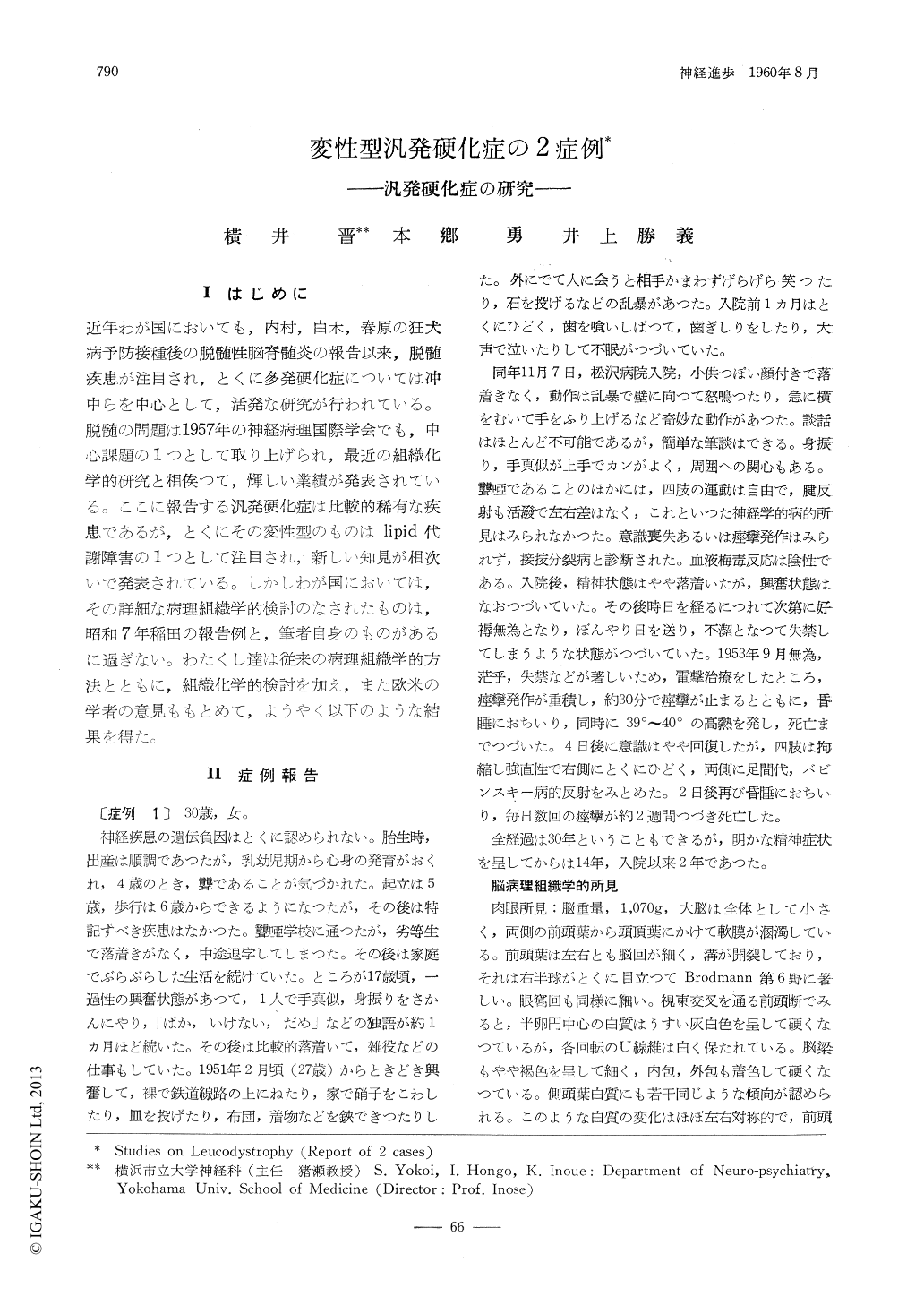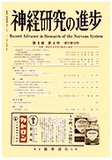Japanese
English
- 有料閲覧
- Abstract 文献概要
- 1ページ目 Look Inside
I はじめに
近年わが国においても,内村,白木,春原の狂犬病予防接種後の脱髄性脳脊髄炎の報告以来,脱髄疾患が注目され,とくに多発硬化症については冲中らを中心として,活発な研究が行われている。脱髄の問題は1957年の神経病理国際学会でも,中心課題の1つとして取り上げられ,最近の組織化学的研究と相俟つて,輝しい業績が発表されている。ここに報告する汎発硬化症は比較的稀有な疾患であるが,とくにその変性型のものはlipid代謝障害の1つとして注目され,新しい知見が相次いで発表されている。しかしわが国においては,その詳細な病理組織学的検討のなされたものは,昭和7年稲田の報告例と,筆者自身のものがあるに過ぎない。わたくし達は従来の病理組織学的方法とともに,組織化学的検討を加え,また欧米の学者の意見ももとめて,ようやく以下のような結果を得た。
A series of necropsied cases of diffuse sclerosishas not infrequently been reported in Westernliteratures. Whereas, the clinicopathological studies on this disease entity in Japan have untilpresent been carried out quite a few. Three casesof leucodystrophy have recently come to ourattention, one subject had already been publishedby Inada 1934 and was refered to this study, while other two were investigated anew. The results thus obtained summarised as follows; 1) No remarkables were noticed in the familyhistory of all patients. The onset of the illnessdeveloped at 17yrs. old in case 1 (female) 47yrs.in case 2 (male) and 37yrs. in case Inada (male).
2) Case 1 who showed a psychomotor excitement at the initial stage, was essentially a congenital oligophrenia and deafness.Other two casesrepresented initially the personality changes, apathetic status and disturbed memory, while theyall fell finally into the dementia in a high degree.The total duration of the illness ranged from1 to 3 years, except for 10 years in case 1.
3) The neurological disturbances such as spastic paralysis especially lower extremities tobodily contracture, convulsive seizures and disturbed consciousness were commonly observed, resulting in death by a general weakness. Thesyndrome of parkisonism such as rigid gait andmovement, mask-like expression and tremor ofextremities was encountred in case Inada.
4) Thus far, the clinical features of this seriescould be differetiated from those of the Westernliteratures in the followings, although they practically consisted of the selected materials ; theonset of the illness was disseminated in all agegroups, but usually developed at an adult age;the symptoms referable to the frontal lesionspredominated, but the visual disturbances werenot observed.
5) A marked atrophy of the cerebral whitematter and a dilatation of the lateral ventricleswere found without exception, while the greymatter as comparatively well preserved. The diffuse demyelination developed symmetrical-bilaterally in the cerebral white matter ; mostly intense in the frontal lobe in all cases, less intensein the parietal and in the occipital.
6) The myelin sheaths of U-fibers were usually resistent, while the cerebellum and the.brain stem were only slightly demyelinated,except for the secondary degeneration of thepyramidal tract, The demyelinated foci in theconvexities of the cerebral cortex accompaniedby the spongious state, inwhere the nerve cellswere relatively preserved but the glial elementsproliferated were disseminated in case 2.
7) The myelin break down products consistedof both so-called neutral fat and prelipid in case1 and case 2, while the former was much morepredominant. The prelipid did not show the brown metachromasia for the acetic acid cresv-violet(Hirsch-Peiffer). The histochemical analysis revealed that the main consistuent of prelipid wasof cerebroside and of sphingomyelin.
8) The astrocytic elements played an importantrole as to the scar formation as well as the transportation of the myelin breakdown productsin all cases, while the microglial elements including fat granule cells were also found in case 2and case Inada as to the latter process. In caseInada some of the granule cells contained the lipopigment which showed a yellow colour and thepositive iron reaction. The intense gliosis occureed, more or less, in the demyelinated foci, butthe former spread much widely the latter.
9) The nerve cells of the cerebral cortex werewell preserved and in the some of them a largeamount of lipid droppet was encountered. Thethalamic nuclei were one of the common sites ofinvolvements, while the caudate nucleus and thepallidum were occasionally affected.
10) The case of Inada is included under thehead of "Case with orthoc'iromatic products ofdecomposition of myelin s'leath and specific lightbrown colour" of the Diezers classification whilecase 1 and case 2 are non-metachromatic leucodystrophy with retarded myelin catabolism.

Copyright © 1960, Igaku-Shoin Ltd. All rights reserved.


